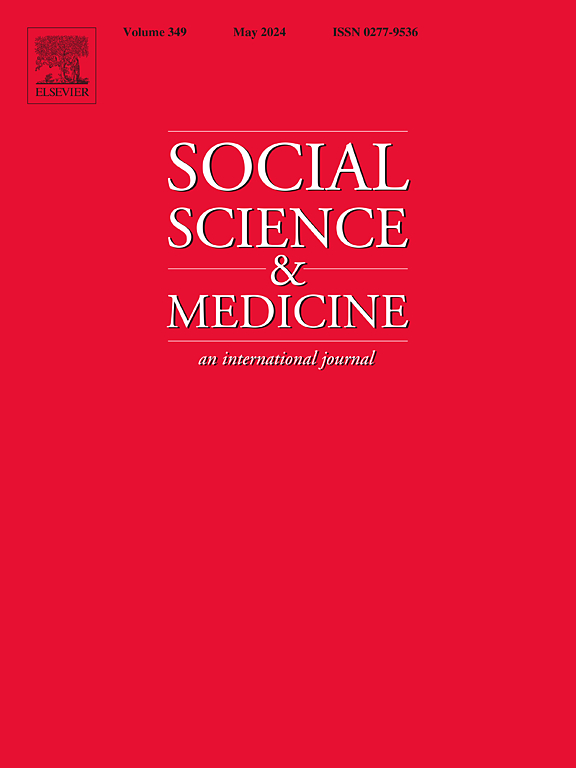Adolescent loneliness and later-life depressive symptoms: The intersecting roles of gender and socioeconomic status
IF 5
2区 医学
Q1 PUBLIC, ENVIRONMENTAL & OCCUPATIONAL HEALTH
引用次数: 0
Abstract
Rationale
Adolescent loneliness has emerged as a pressing public health issue in many developed countries, drawing increasing attention for its potential long-term psychological consequences.
Objective
This study examines the association between adolescent loneliness and depressive symptoms in adulthood and explores how gender and socioeconomic factors, such as college attainment and personal earnings, moderate this relationship.
Methods
Using data from the National Longitudinal Study of Adolescent to Adult Health, this study employs sibling fixed effects models to account for unobserved family-level confounding factors. Gender-stratified models and two- and three-way interaction models are used to investigate how gender and socioeconomic factors shape the relationship between adolescent loneliness and adult depressive symptoms.
Results
The positive association between adolescent loneliness and depressive symptoms remains significant after accounting for individual- and familial-level covariates, including sibling fixed effects (b = 0.988, p < 0.001). This suggests that the relationship persists independently of unobserved family background characteristics. Gender-specific analyses indicate that college attainment significantly moderates this association for women, but not for men. A three-way interaction between loneliness, college attainment, and gender (b = −1.327, p < 0.05) further supports the gendered moderating role of education. In contrast, personal earnings do not moderate the relationship in either gender.
Conclusion
The findings of this study highlight the potential long-term psychological consequences of adolescent loneliness and the importance of interventions across the lifespan. Efforts to support women with lower levels of education may be particularly important in mitigating the heightened psychological effects of loneliness and reducing mental health disparities.
青少年孤独和晚年抑郁症状:性别和社会经济地位的交叉作用
在许多发达国家,青少年孤独已成为一个紧迫的公共卫生问题,其潜在的长期心理后果引起了越来越多的关注。目的研究青少年孤独感与成年期抑郁症状之间的关系,并探讨性别和社会经济因素(如大学学历和个人收入)如何调节这种关系。方法使用国家青少年至成人健康纵向研究的数据,本研究采用兄弟姐妹固定效应模型来解释未观察到的家庭水平混杂因素。本文采用性别分层模型和双向及三向互动模型探讨性别和社会经济因素如何影响青少年孤独感与成人抑郁症状之间的关系。结果在考虑个体和家庭水平的协变量(包括兄弟姐妹固定效应)后,青少年孤独感与抑郁症状之间的正相关仍然显著(b = 0.988, p < 0.001)。这表明这种关系独立于未观察到的家庭背景特征而存在。针对不同性别的分析表明,大学学历对女性的这种关联有显著调节作用,但对男性则没有。孤独感、大学学历和性别之间存在三向交互作用(b = - 1.327, p < 0.05),进一步支持教育的性别调节作用。相比之下,个人收入并不能调节男女之间的关系。结论本研究的发现强调了青少年孤独感的潜在长期心理后果,以及在整个生命周期中进行干预的重要性。努力支持受教育程度较低的妇女,对于减轻孤独感造成的严重心理影响和缩小心理健康差距可能特别重要。
本文章由计算机程序翻译,如有差异,请以英文原文为准。
求助全文
约1分钟内获得全文
求助全文
来源期刊

Social Science & Medicine
PUBLIC, ENVIRONMENTAL & OCCUPATIONAL HEALTH-
CiteScore
9.10
自引率
5.60%
发文量
762
审稿时长
38 days
期刊介绍:
Social Science & Medicine provides an international and interdisciplinary forum for the dissemination of social science research on health. We publish original research articles (both empirical and theoretical), reviews, position papers and commentaries on health issues, to inform current research, policy and practice in all areas of common interest to social scientists, health practitioners, and policy makers. The journal publishes material relevant to any aspect of health from a wide range of social science disciplines (anthropology, economics, epidemiology, geography, policy, psychology, and sociology), and material relevant to the social sciences from any of the professions concerned with physical and mental health, health care, clinical practice, and health policy and organization. We encourage material which is of general interest to an international readership.
 求助内容:
求助内容: 应助结果提醒方式:
应助结果提醒方式:


